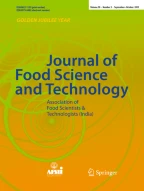Abstract
Direct acidified Cottage cheese could be kept well for only 10 to 12 days under refrigeration on account of its high moisture (~74 %) content and relatively high pH (~5.0). The study was, therefore, undertaken to improve the keeping quality of direct acidified Cottage cheese using MicroGARD. The effects of three different levels of MicroGARD 400 viz. 0.20, 0.35 and 0.50 % on the physico-chemical, microbiological and organoleptic properties were studied at four-day interval during storage under refrigeration (4–5 °C). Promising results were found using 0.50 % MicroGARD 400 for inhibiting psychrotrophs, yeasts and molds as well as retard the acidity development and proteolysis in Cottage cheese, thus extending its keeping quality. It was observed that addition of MicroGARD 400 at the level of 0.50 % considerably improved the flavour as well as the aesthetic quality of the product during storage and extended the shelf life of Cottage cheese from 12 to 26 days.


Similar content being viewed by others
References
ADSA (2004) Cottage cheese score card, 2003 Rules. In: 83rd Annual collegiate dairy products evaluation contest. Committee on Dairy Product Evaluation, Amarican Dairy Science Association. 1111 N. Dunlap Avenue Savoy. IL 61874. USA. p 16
Al-Zoreky N, Ayres JW, Sandine WE (1991) Antimicrobial activity of MicroGARD™ against food spoilage and pathogenic microorganisms. J Dairy Sci 74:758–763
Angevine NC (1959) Keeping quality of cottage cheese. J Dairy Sci 42:2015–2019
AOAC (2000) Association of official analytical chemists. In: Horwitz W (ed) Official methods of analysis, Vol. II, 17th edn. Assc Official Agric Chem, Washington DC
Daeschel AM (1989) Antimicrobial substances from lactic acid bacteria for use as food preservatives. Food Technol 43:91–94
Deeth HC, Fitz-Gerald CH (1976) Lipolysis in dairy products: a review. Aust J Dairy Technol 31:53–64
Emmons DB, Tuckey SL (1967) Cottage cheese and other cultured milk products. Has Pfizer & Co, Inc, New York
Evanston IL (1990) System of Statistics (SYSTAT). Evanston IL (ed), Wilkinson
Fox PF, Guinee TP, Cogan TM, McSweeney PLH (2000) Fundamental of cheese science. Aspen Publishers, Inc, Gaithersburg, pp 236–279
Harmon LG, Smith CL (1956a) Spoilage organisms in cottage cheese. J Dairy Sci 39:9–15
Harmon LG, Smith CL (1956b) The influence of environment and processing in spoilage organisms in Cottage cheese. J Dairy Sci 19:252–255
Houghtby GA, Maturin LJ, Koenig EK (1993) In: Marshall RT (ed) Microbiological count methods, 16th edn. American Public Health Association (APHA), Washington DC, pp 213–246
ISO 8586:1993E. Sensory analysis-methodology-general guidance. International Organization for Standardization, Geneva, Switzerland
ISO 8586-1:1993E. Sensory analysis-general guidance for the selection, training and monitoring of assessors. International Organization for Standardization, Geneva, Switzerland
Johnson P (1979) Cottage cheese: a primer for high quality and long shelf life. Am Dairy Rev 41:40O–40P, 40T-40V, 40X-40Z
Kosikowski FV (1982) Cottage cheese. In: Kosikowski FV (ed) Cheese and fermented milk foods, 2nd edn. F. V. Kosikowski and Associates, New York, pp 109–143
Llyod AG, Drake JJP (1975) Problems posed by essential food preservatives. Br Med Bull 31:214–219
Luck H, Mosteret JF, Husmann RA (1977) Shelf life of perishable dairy products. S Afr J Dairy Technol 9:25–27
Makhal S, Kanawjia SK (2003a) Preservation of Cottage cheese: a review. Indian J Dairy Sci 56(10):1–12
Makhal S, Kanawjia SK (2003b) Microbial metabolites in preserving dairy products—an overview. J Food Dairy Home Sci 23:157–171
Makhal S, Mandal S, Kanawjia SK (2003) MicroGARDTM in food preservation: a shifted paradigm towards natural preservatives. Indian J Dairy Biosci 14:70–78
Makhal S, Giri A, Kanawjia SK (2011) Effect of κ-carrageenan and tetrasodium pyrophosphate on the yield of direct acidified cottage cheese. J Food Sci Technol. doi:10.1007/s13197-011-0438-5
Makhal S, Kanawjia SK, Giri A (2012) Effectiveness of thymol in extending keeping quality of cottage cheese. J Food Sci Technol. doi:10.1007/s13197-012-0715-y
Makhal S, Kanawjia SK, Giri A (2013) Role of calcium chloride and heat treatment singly and in combination on improvement of the yield of direct acidified Cottage cheese. J Food Sci Technol. doi 10.1007/s13197-013-1028-5
Robinson RK (1981) Dairy microbiology, vol 2. Elsevier Science Publishers Ltd, London
Salih MA, Sandine WE, Ayres JW (1990) Inhibitory effects of MicroGARDTM on yoghurt and Cottage cheese spoilage organisms. J Dairy Sci 73:887–893
Scafer JG (1958) Cottage cheese sanitation practice. Am Milk Rev 20:42–44
Shakeel-Ur-Rehman, Farkye NY, Drake MA (2003) Reduced fat Cheddar cheese from a mixture of cream and liquid milk protein concentrate. Int J Dairy Technol 56:94–98
Suriyarachchi RV, Fleet HG (1981) Occurrence and growth of yeast in yogurts. Appl Environ Microbiol 42:574–577
Walstra P, Jenness R (1984) Dairy chemistry and physics. John Wiley & Sons, New York
Weber GH, Broich WA (1986) Shelf life extension of cultured dairy foods. Cult Dairy Prod J 21:19–23
Author information
Authors and Affiliations
Corresponding author
Rights and permissions
About this article
Cite this article
Makhal, S., Kanawjia, S.K. & Giri, A. Effect of microGARD on keeping quality of direct acidified Cottage cheese. J Food Sci Technol 52, 936–943 (2015). https://doi.org/10.1007/s13197-013-1055-2
Revised:
Accepted:
Published:
Issue Date:
DOI: https://doi.org/10.1007/s13197-013-1055-2



